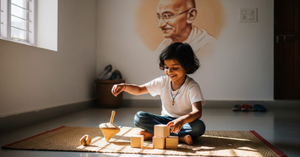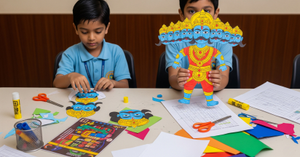Independence Day in India is typically celebrated with parades, patriotic songs, and tricolour treats. While these traditions build national pride, they often involve long hours of sitting and indulging in sweets, chips, or fried foods. What if we reimagined the day to also honour our body’s freedom to move, play, and feel strong?
Physical inactivity is one of the rising concerns among Indian families, especially after the pandemic. According to a 2023 Indian Council of Medical Research report, nearly 2 in 5 children in urban areas do not meet the recommended daily physical activity levels. The consequences are far-reaching, ranging from childhood obesity to poor emotional regulation and even lowered academic performance.
This Independence Day, let’s take a step beyond watching the parade and use the day to model active, joyful, and inclusive fitness habits for the whole family.
Why Family Fitness Matters
Parents are the most powerful role models for children when it comes to health behaviours. Studies from the Journal of Paediatrics and the Lancet Child & Adolescent Health show that children who grow up in active households are more likely to develop lifelong healthy habits. Physical activity:
- Enhances cardiovascular and bone health
- Regulates weight and appetite
- Boosts mood and reduces screen dependence
- Improves sleep and academic concentration
More importantly, fitness as a family builds connection, communication, and collective discipline, qualities that support both health and harmony at home.
Reimagining Independence Day with Movement
Here are simple, creative, and budget-friendly ways to integrate fitness into your Independence Day celebrations:
1. Start the Morning with a Family Yoga Flow
Begin the day with a gentle 20-minute yoga session that all family members can follow. Include asanas like Surya Namaskar, Vrikshasana (Tree Pose), and Tadasana, which promote posture, balance, and mindfulness.
Many school children already know these poses from morning assemblies. Doing it together not only improves flexibility but fosters shared purpose and calm.
2. Create a Tricolour Fitness Trail in Your Home or Colony
Design an activity trail with three coloured stations (saffron, white, green). Assign each colour a movement:
- Saffron: High-energy movement like jumping jacks or skipping
- White: Balance or mindfulness pose like standing on one foot or breathing exercises
- Green: Strength-based movements like squats or wall sits
You can even offer tokens or badges for each completed circuit. Invite neighbours or friends to join and make it a mini event.
3. Organise a Patriotic Dance Jam
Replace the television with music and move to patriotic songs. Whether it’s Jai Ho or Maa Tujhe Salaam, pick energetic numbers and choreograph simple steps together. Dancing is an excellent form of aerobic activity and can burn 150–300 calories in just 30 minutes for adults and children alike.
4. Walk to a Local Park Instead of Driving
Instead of a drive-through celebration or restaurant outing, take a walk to a nearby park, lake, or garden. Carry home-made tricolour snacks like carrot sticks, idli with chutney, or fruit skewers. Walking as a family encourages conversation, reduces screen time, and models eco-conscious behaviour.
5. Run a “Fit for Freedom” Family Challenge
Make a simple leaderboard for the week around physical activity. Track who walked the most steps, skipped the longest, or did the most wall sits. Use Independence Day to launch this challenge and give out homemade medals or tricolour stickers as encouragement.
This gamifies movement and gives children a sense of healthy competition and reward without pressure.
6. Clean, Stretch, and Play Together
Use the holiday to do a group cleaning activity. Mopping, dusting, or organising bookshelves are moderate physical activities that burn calories and build motor skills in children. End the cleaning with a fun 10-minute stretch or playful chase in the house.
This promotes both physical wellness and household responsibility.
7. Mindful Screen Time and Tech Breaks
Use Independence Day to take a break from screens. No phones during meals. No YouTube unless it’s a fitness or dance video. Encourage kids to write a short essay or draw about “What fitness means to me” and share it aloud.
Freedom from screen addiction is just as important as freedom of movement.
Making Fitness Sustainable, Not Seasonal
While Independence Day is a good starting point, the goal is to weave these habits into daily life. Here’s how:
- Block 30 minutes daily as “family active time”
- Limit sugary snacks and introduce fruit bowls or peanut chikki
- Encourage outdoor play even in small spaces like terraces or driveways
- Use fitness rewards instead of food rewards
- Get kids involved in tracking their physical activity with stickers or step counters
According to NHS and WHO guidelines, children between 5–17 years should get at least 60 minutes of moderate-to-vigorous activity daily, while adults should aim for 150 minutes per week. Even house chores, climbing stairs, and dancing count toward this target.
Common Myths About Family Fitness
Myth: Children are naturally active. They don’t need structured exercise.
Truth: With rising screen exposure and academic pressure, many children today are sedentary for long hours. Structured and free play are both essential.
Myth: Fitness means going to the gym.
Truth: Walking, skipping, playing hide-and-seek, or climbing stairs are excellent forms of fitness. Gym equipment is not mandatory for health.
Myth: One active day can compensate for a week of inactivity.
Truth: Physical activity needs to be consistent to show health benefits. Weekend-only activity does not reverse the risks of sedentary living.
When to Seek Medical Advice
Before starting any new fitness routine, consult your child’s paediatrician if:
- The child has asthma, cardiac issues, joint problems, or obesity-related complications
- There is fatigue, chest discomfort, or fainting during activity
- Your child has developmental delays or coordination challenges
A tailored plan from a doctor or paediatric physiotherapist can make movement safe and accessible for all children.
Conclusion
Freedom is not just the absence of oppression; it is the presence of well-being. As we raise flags and sing anthems this August 15, let us also move, play, and breathe as a family in honour of our freedom to live fully and healthily.
Family fitness is not a luxury. It is a foundational act of care, courage, and connection. Start small. Walk together. Dance together. Breathe together. Because the best gift we can give our children on Independence Day is the habit of health and the joy of movement.








Be the first one to comment on this story.